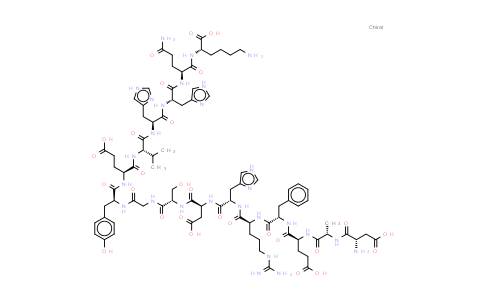
β-Amyloid (1-16) NLT 98%
Product Number : MC517526
CAS Number : 131580-10-4
Molecular Formula : C84H119N27O28 | Molecular Weight : 1955.01
Synonyms : Amyloid β-Protein (1-16)
Quote Request| Purity | NLT 98% |
|---|---|
| Storage | at 20ºC 2 years |
| MolCore specializes in manufacturing high-purity CAS No.131580-10-4, β-Amyloid (1-16) with the molecular formula C84H119N27O28 and molecular weight 1955.01 delivering critical API intermediates for global pharmaceutical and research industries, certified under ISO quality systems. | |
* The above information is for reference only.
| Chemical Name | β-Amyloid (1-16) |
|---|---|
| CAS Number | 131580-10-4 |
| MDL Number | MFCD00214592 |
| Molecular Formula | C84H119N27O28 |
| Molecular Weight | 1955.01 |
| Synonyms | Amyloid β-Protein (1-16) |
β-Amyloid (1-16) is a β-Amyloid protein fragment involved in metal binding. Beta-amyloid is a peptide that forms amyloid plaques in the brains of Alzheimer's disease (AD) patients. IC50 & Target: Amyloid-β[1] In Vivo: β-amyloid (1-16) fragment is considered as valid models to examine the contribution of the key histidine residues (His , His in mouse and His , His , His in human fragments) to the Ab–Cu2+ interaction. Oxidation targets for β-Amyloid (1-16) are the histidine residues coordinated to the metal ions. Copper is bound to Aβ in senile plaque of Alzheimer’s disease with β-Amyloid (1-16) taking part in the coordination of the Cu2+ ions. Cu2+ and Zn2+ are linked with the neurotoxicity of -Amyloid and free radical damage[1]. β-amyloid (1-16) is the minimal amino acidic sequence display a Cu coordination mode which involves three Histidines (His6, His13 and His14). β-amyloid (1-16) is supposed to be involved in metal binding[2]. Human β-amyloid interacts with zinc ions through its metal-binding domain 1-16. The C-tails of the two polypeptide chains of the rat Aβ(1-16) dimer are oriented in opposite directions to each other, which hinders the assembly of rat Aβ dimers into oligomeric aggregates. Thus, the differences in the structure of zinc-binding sites of human and rat β-Amyloid (1-16), their ability to form regular cross-monomer bonds, and the orientation of their hydrophobic C-tails could be responsible for the resistance of rats to Alzheimer's disease[3].
© Copyright 2015-2025 Hangzhou MolCore BioPharmatech Co.,Ltd. All rights reserved.
